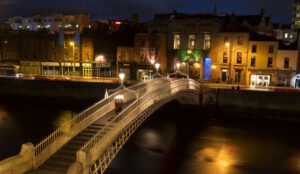 DAY -1/ WELCOME TO IRELAND AND HISTORIC DUBLIN
DAY -1/ WELCOME TO IRELAND AND HISTORIC DUBLIN
Spend the day soaking up the atmosphere of this exciting city and visit some of its many attractions such as the Guinness Storehouse, Trinity College or Old Jameson Distillery.
Overnight, B&B at your hotel in the Dublin area
DAY -2/ DUBLIN TO BELFAST
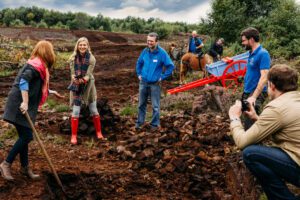 This morning head northwards towards Belfast. From Newry, travel east through the scenic Mourne Region and on to Downpatrick where you can visit the Saint Patrick Centre The Saint Patrick Centre, one of Northern Ireland’s major Millennium Projects, is the first permanent exhibition to tell the story of Ireland’s Patron Saint.
This morning head northwards towards Belfast. From Newry, travel east through the scenic Mourne Region and on to Downpatrick where you can visit the Saint Patrick Centre The Saint Patrick Centre, one of Northern Ireland’s major Millennium Projects, is the first permanent exhibition to tell the story of Ireland’s Patron Saint.
Following the visit, you can also visit Down Cathedral, in whose churchyard St. Patrick is reputed to be buried. Continuing on from Downpatrick, you arrive at Castle Ward, a beautiful 300-ha (750acre) walled estate in a stunning location overlooking Strangford Lough.
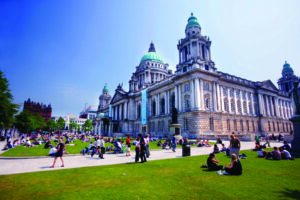 Belfast City
Belfast City
Your next stop is Belfast, where you can wander around the city center and admire some exquisite examples of Georgian, Victorian and Edwardian architecture, dominated by the magnificently domed City Hall. This Renaissance-style building of Portland stone was completed in 1906 and each of the building’s corners has a tower. Its graceful dome rises in the center to 185 feet. Half a mile from this area is Queens University, with its mellow brickwork and Tudor cloister.
Overnight, B&B at your hotel in the Belfast area
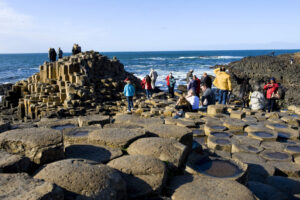 DAY -3/ BELFAST TO BALLYMENA
DAY -3/ BELFAST TO BALLYMENA
Gobbins Cliff Path
Your Causeway Coastal Route adventure begins from the city of Belfast. Heading north from Belfast, Belfast Lough will glisten to your right as you join the Causeway Coastal Route at Newtownabbey and cruise towards the seaside town of Carrickfergus. The town’s harbor-side Norman 12th Century castle has seen over 800 years of action, right up until World War II, with portcullis ramparts, canons and a chilling dungeon. Glorious coastal scenes are a taster for what is to come as you reach 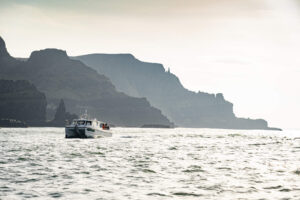 , where the impressive Gobbins Cliff Path awaits!
, where the impressive Gobbins Cliff Path awaits!
Hanging from basalt cliffs directly over the Irish Sea, the Gobbins Cliff Path is an Edwardian labor of love. "Step through a portal in the rock and onto a pathway over the sea. Peer into the ever-changing waters of the North Passage from the railings of a tubular bridge. Venture between outcrops and across the mouths of yawning caves".

Glens of Antrim
After braving the elements on the Gobbins Path, continue to Larne. Larne is known locally as the gateway to the nine Glens of Antrim: glacier-gouged valleys of seaside villages and highlands of coniferous forests. Continue north along the crumbling coast and you’ll reach Ballygally where you can enjoy walks along its beautiful golden beach. Make sure to visit Ballygally Castle. The old castle is rooted in local myth and legend and is even said to have a resident ghost. Just north of Ballygally, the sublime Carnfunnock Country Park is a must-visit.
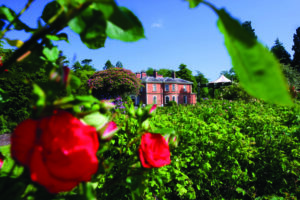
This Garden of Eden has glorious views of the County Antrim coastline, Carnfunnock has woodlands, colorful gardens and walking trails.
Glenarm Castle
Continue north along the coast and visit one of Ireland’s oldest estates: Glenarm Castle. There has been a castle at Glenarm since the 13th century. It’s open to the public from May to September, and a stroll around the immaculately kept walled gardens is the perfect precursor to lunch in the castle tearooms. The village of Broughshane and the mighty Slemish Mountain are next. 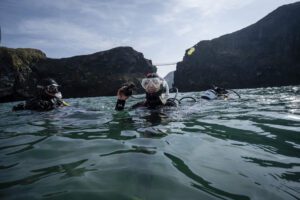
The latter is the lonely spot where St. Patrick was first bonded to slavery on his arrival to Ireland. Swing west and inland now to reach the town of Ballymena.
With plenty of shops, restaurants and local attractions, Ballymena is the perfect place to end the first day of your Causeway Coastal Route journey.
Overnight, B&B at your hotel in the Dublin area
 DAY -4/ BALLYMENA TO PORTRUSH
DAY -4/ BALLYMENA TO PORTRUSH
Fully refreshed, today has you traveling from Ballymena to Portrush. You’re in the heart of the Glens of Antrim now, and there’s no better way to experience the majesty of the area than with a visit to Glenariff Forest Park.
Take your pick from the four walking routes, which wind around a fantasy landscape of cascading Essna-Crub waterfall and rivers. Other highlights of the area include the Vanishing Lake and the Ballypatrick Forest Park. Cushendun itself is landmarked by the curiously shaped Curfew Tower.
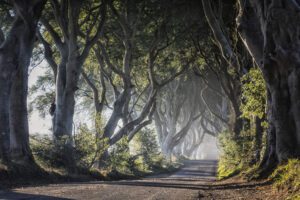 The Dark Hedges
The Dark Hedges
While you’re in the neighborhood we recommend seeing one of Northern Ireland’s most iconic sites: the Dark Hedges , the iconic trees that have been used as a filming location in HBO's epic series Game of Thrones®, representing the Kingsroad, north of King's Landing. Like something straight out of a Hans Christian Andersen tale, a long country road is framed by interlocking beech trees, creating a mesmerizing vista. With the Dark Hedges explored, continue to the one of the superstars of the Causeway Coastal Route:
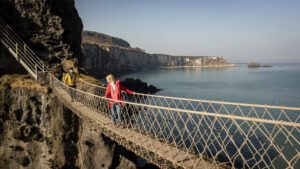 Carrick-a-Rede rope-bridge.
Carrick-a-Rede rope-bridge.
With views of Rathlin Island and Scotland for the area, graveled-step path brings you on a 1.0 kilometer walk to the bridge, which connects the mainland to the tiny island of Carrick-a-Rede. The bridge spans a 20-metre chasm some 30-metres above the crashing waves below It was originally built by local salmon fisherman in 1755 to provide access to the island. Carrickarede Island is the best example of a Volcanic Plug in Northern Ireland.
 The Giants Causeway
The Giants Causeway
With your heart still pounding, head west and into another heavy hitter of the Causeway Coastal Route: the Giant’s Causeway. An official UNESCO World Heritage Site, here, some 40,000 hexagonal columns blanket the landscape and peter out into the ocean. According to science, intense volcanic activity millennia ago created this whimsical landscape. But we much prefer the local version that tells of warring giants and heroic acts resulting in the Causeway. The Giant’s Causeway Visitor Centre elaborates on both the scientific and mythic explanations.
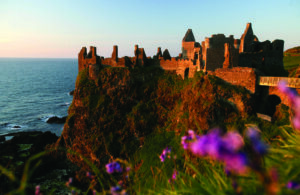 Dunluce Castle
Dunluce Castle
Head back to the coast and discover Dunluce Castle. It’s hard to imagine a more dramatic setting for the ruins of this 14th century reputed O’Neill castle. Set at the edge of a cliff top, the castle looks like it may plummet into the water. Have your camera batteries charged, as Dunluce Castle at sunset is one of the most striking sights you will see anywhere in the world. The day ends in nearby Portrush, famed for its golden beaches, brilliant surf and world-class golf course – Royal Portrush.
Overnight, B&B at your hotel in the Dublin area
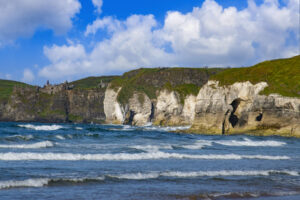 DAY -5/ PORTRUSH TO DERRY
DAY -5/ PORTRUSH TO DERRY
With Portrush in your rearview mirror, take a short drive to the seaside town of neighboring Portstewart. Here, you can enjoy the beautiful Portrush Whiterocks Beach, which has recently been awarded a Blue Flag Beach title.
If you fancy a spot of surfing, this is also a great place. Plenty of local shops supply all the equipment and lessons needed. Out of the water, a variety of caves, arches and headlands are great for scenic walks.
 Mesolithic site of Mountsandel
Mesolithic site of Mountsandel
Swing inland and head for the university town of Coleraine. You may choose to stop here for lunch, then visit one of the oldest known human settlements in Ireland at Mountsandel, just a mile outside town. A Mesolithic site, it is one of the oldest archaeological sites in Ireland with carbon dating indicating an age of 9,000 years old. Back on the coast and heading west, a stop at Mussenden Temple near Castlerock is a must. Looking like a relic from ancient Rome, built in 1785, this one-time library is perched precariously on a cliff top with commanding views over the panoramic coast. 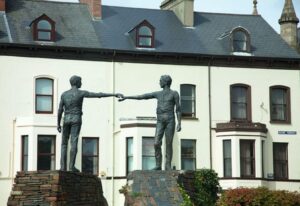 After you’ve explored Limavady, head towards the Binevenagh Mountain. As an official Area of Outstanding Natural Beauty, you can expect breathtaking views from the summit. Your final destination today is the historic walled City of Derry.
After you’ve explored Limavady, head towards the Binevenagh Mountain. As an official Area of Outstanding Natural Beauty, you can expect breathtaking views from the summit. Your final destination today is the historic walled City of Derry.
City Of Derry
As you approach, don’t be alarmed by the cannons on top of the huge city walls; they’re purely decorative.
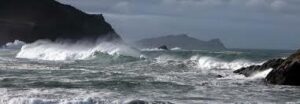 Inside, a warren of side streets, main streets, pubs, shops, theatres, restaurants and attractions of all sorts make Derry one of Ireland’s most compelling cultural cities. So ends your coastal odyssey along the Causeway Coastal Route.
Inside, a warren of side streets, main streets, pubs, shops, theatres, restaurants and attractions of all sorts make Derry one of Ireland’s most compelling cultural cities. So ends your coastal odyssey along the Causeway Coastal Route.
Overnight, B&B at your hotel in the Derry area
 DAY -6/ DERRY TO ENNISKILLEN
DAY -6/ DERRY TO ENNISKILLEN
This morning, head north towards the Inishowen peninsula. The Inishowen Peninsula with Lough Foyle to the east and Lough Swilly to the west reaches out into the Atlantic, where commences the “Wild Atlantic Way” and extends to Ireland’s northernmost point: Malin Head.
Donegal
The landscape is typically Donegal: rugged; desolate and mountainous. 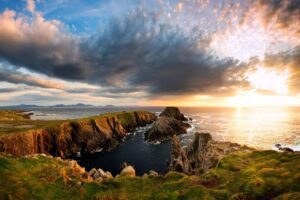 Ancient sites abound, but there are also some wonderful beaches and plenty of sites to visit. The peninsula is a European Special area of Conservation and home to over 100 species of migrating and indigenous bird life. After your tour of this amazing part of Ireland start your route towards Ennikskillen. On the way pass by Donegal Town and keep on heading south to County Fermanagh.
Ancient sites abound, but there are also some wonderful beaches and plenty of sites to visit. The peninsula is a European Special area of Conservation and home to over 100 species of migrating and indigenous bird life. After your tour of this amazing part of Ireland start your route towards Ennikskillen. On the way pass by Donegal Town and keep on heading south to County Fermanagh.
Fermanagh County
The beautiful County of Fermanagh is a visitor’s paradise with wide stretches of island dotted waterway and secluded bays surrounded by a patchwork of green fields. 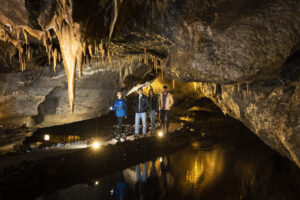 Situated in the Northwest of Ireland, Fermanagh boasts one of the most uncongested lakes in Europe – Lough Erne. Lough Erne is made up of two channels, the lower and the upper Loughs. Where the two Loughs meet stands the island town of Enniskillen, also known as the county town. The origins of the island town of Enniskillen go back to prehistory when this short nexus was the main highway between Ulster and Connaught. Fermanagh has a lot to offer and is best known for the quality of its fishing.
Situated in the Northwest of Ireland, Fermanagh boasts one of the most uncongested lakes in Europe – Lough Erne. Lough Erne is made up of two channels, the lower and the upper Loughs. Where the two Loughs meet stands the island town of Enniskillen, also known as the county town. The origins of the island town of Enniskillen go back to prehistory when this short nexus was the main highway between Ulster and Connaught. Fermanagh has a lot to offer and is best known for the quality of its fishing.
Overnight, B&B at your hotel in the Enniskillen area
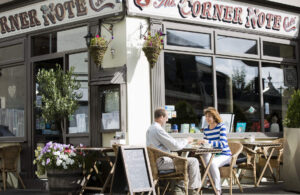 DAY 7/ ENNISKILLEN TO DUBLIN
DAY 7/ ENNISKILLEN TO DUBLIN
This morning, commence your journey back to Dublin, perhaps travelling through the Boyne Valley region whose banks are lined with landmarks from almost every phase of Ireland’s past - from the prehistoric passage tombs at Newgrange, to the legendary Hill of Tara, seat of the Irish High Kings as well as monuments from the early days of Christianity.You can visit Oldbridge House with its Visitor Centre telling the story of the Battle of the Boyne, fought between King William III and his father-in-law, King James IIon 1 July 1690 (11 July according to our modern calendar). Both kings commanded their armies in person, 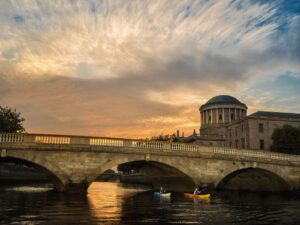 36,000 on the Williamite side and 25,000 on the Jacobite side - the largest number of troops ever deployed on an Irish battlefield. You can visit the nearby Brú Na Bóinne Visitor Centre which tells the history of the region and either Newgrange or Knowth burial passages.
36,000 on the Williamite side and 25,000 on the Jacobite side - the largest number of troops ever deployed on an Irish battlefield. You can visit the nearby Brú Na Bóinne Visitor Centre which tells the history of the region and either Newgrange or Knowth burial passages.
Overnight, B&B at your hotel in the Dublin area
DAY -8/ FAREWELL
After a well needed overnight you will start fresh with a final full Irish breakfast at your Hotel, travel to Dublin Airport for your return flight home.
 "Hi, I'm Benny, a native of Ireland, born and raised in Ireland."
"Hi, I'm Benny, a native of Ireland, born and raised in Ireland."


 DAY -1/ WELCOME TO IRELAND AND HISTORIC DUBLIN
DAY -1/ WELCOME TO IRELAND AND HISTORIC DUBLIN This morning head northwards towards Belfast. From Newry, travel east through the scenic Mourne Region and on to Downpatrick where you can visit the Saint Patrick Centre The Saint Patrick Centre, one of Northern Ireland’s major Millennium Projects, is the first permanent exhibition to tell the story of Ireland’s Patron Saint.
This morning head northwards towards Belfast. From Newry, travel east through the scenic Mourne Region and on to Downpatrick where you can visit the Saint Patrick Centre The Saint Patrick Centre, one of Northern Ireland’s major Millennium Projects, is the first permanent exhibition to tell the story of Ireland’s Patron Saint. Belfast City
Belfast City DAY -3/ BELFAST TO BALLYMENA
DAY -3/ BELFAST TO BALLYMENA , where the impressive Gobbins Cliff Path awaits!
, where the impressive Gobbins Cliff Path awaits!


 DAY -4/ BALLYMENA TO PORTRUSH
DAY -4/ BALLYMENA TO PORTRUSH The Dark Hedges
The Dark Hedges Carrick-a-Rede rope-bridge.
Carrick-a-Rede rope-bridge. Dunluce Castle
Dunluce Castle DAY -5/ PORTRUSH TO DERRY
DAY -5/ PORTRUSH TO DERRY Mesolithic site of Mountsandel
Mesolithic site of Mountsandel After you’ve explored Limavady, head towards the Binevenagh Mountain. As an official Area of Outstanding Natural Beauty, you can expect breathtaking views from the summit. Your final destination today is the historic walled City of Derry.
After you’ve explored Limavady, head towards the Binevenagh Mountain. As an official Area of Outstanding Natural Beauty, you can expect breathtaking views from the summit. Your final destination today is the historic walled City of Derry. Inside, a warren of side streets, main streets, pubs, shops, theatres, restaurants and attractions of all sorts make Derry one of Ireland’s most compelling cultural cities. So ends your coastal odyssey along the Causeway Coastal Route.
Inside, a warren of side streets, main streets, pubs, shops, theatres, restaurants and attractions of all sorts make Derry one of Ireland’s most compelling cultural cities. So ends your coastal odyssey along the Causeway Coastal Route. Ancient sites abound, but there are also some wonderful beaches and plenty of sites to visit. The peninsula is a European Special area of Conservation and home to over 100 species of migrating and indigenous bird life. After your tour of this amazing part of Ireland start your route towards Ennikskillen. On the way pass by Donegal Town and keep on heading south to County Fermanagh.
Ancient sites abound, but there are also some wonderful beaches and plenty of sites to visit. The peninsula is a European Special area of Conservation and home to over 100 species of migrating and indigenous bird life. After your tour of this amazing part of Ireland start your route towards Ennikskillen. On the way pass by Donegal Town and keep on heading south to County Fermanagh. Situated in the Northwest of Ireland, Fermanagh boasts one of the most uncongested lakes in Europe – Lough Erne. Lough Erne is made up of two channels, the lower and the upper Loughs. Where the two Loughs meet stands the island town of Enniskillen, also known as the county town. The origins of the island town of Enniskillen go back to prehistory when this short nexus was the main highway between Ulster and Connaught. Fermanagh has a lot to offer and is best known for the quality of its fishing.
Situated in the Northwest of Ireland, Fermanagh boasts one of the most uncongested lakes in Europe – Lough Erne. Lough Erne is made up of two channels, the lower and the upper Loughs. Where the two Loughs meet stands the island town of Enniskillen, also known as the county town. The origins of the island town of Enniskillen go back to prehistory when this short nexus was the main highway between Ulster and Connaught. Fermanagh has a lot to offer and is best known for the quality of its fishing. DAY 7/ ENNISKILLEN TO DUBLIN
DAY 7/ ENNISKILLEN TO DUBLIN 36,000 on the Williamite side and 25,000 on the Jacobite side - the largest number of troops ever deployed on an Irish battlefield. You can visit the nearby Brú Na Bóinne Visitor Centre which tells the history of the region and either Newgrange or Knowth burial passages.
36,000 on the Williamite side and 25,000 on the Jacobite side - the largest number of troops ever deployed on an Irish battlefield. You can visit the nearby Brú Na Bóinne Visitor Centre which tells the history of the region and either Newgrange or Knowth burial passages.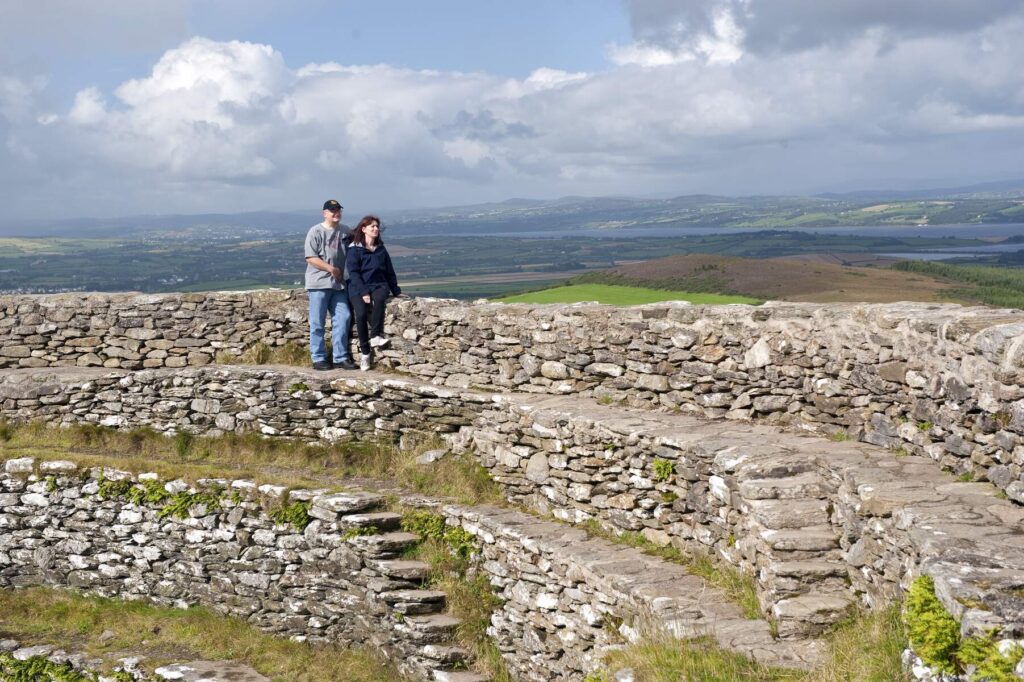
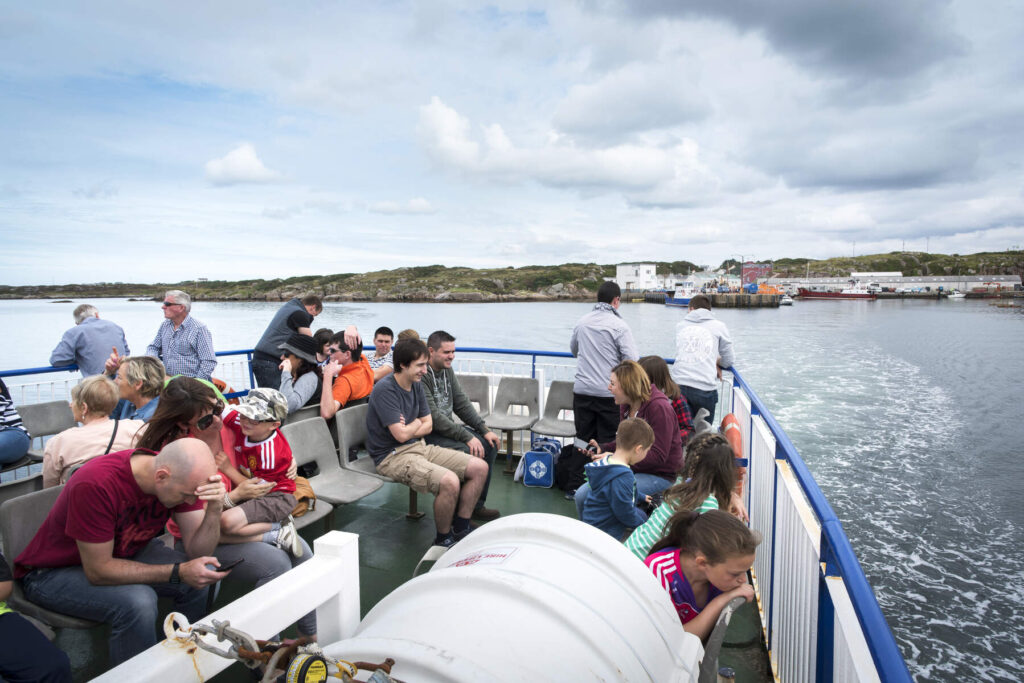
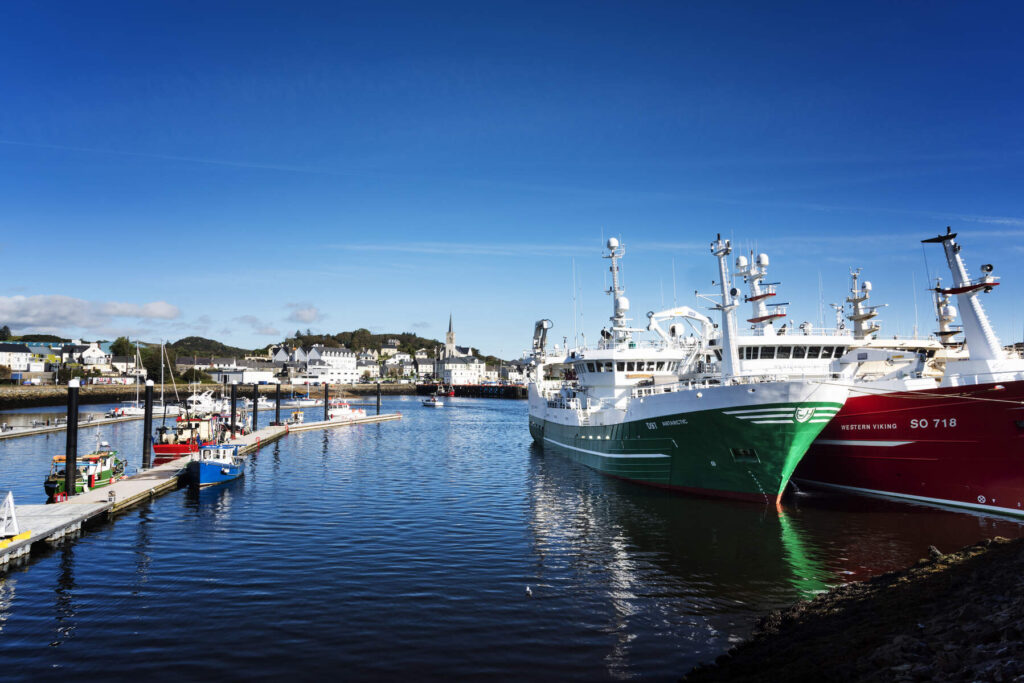
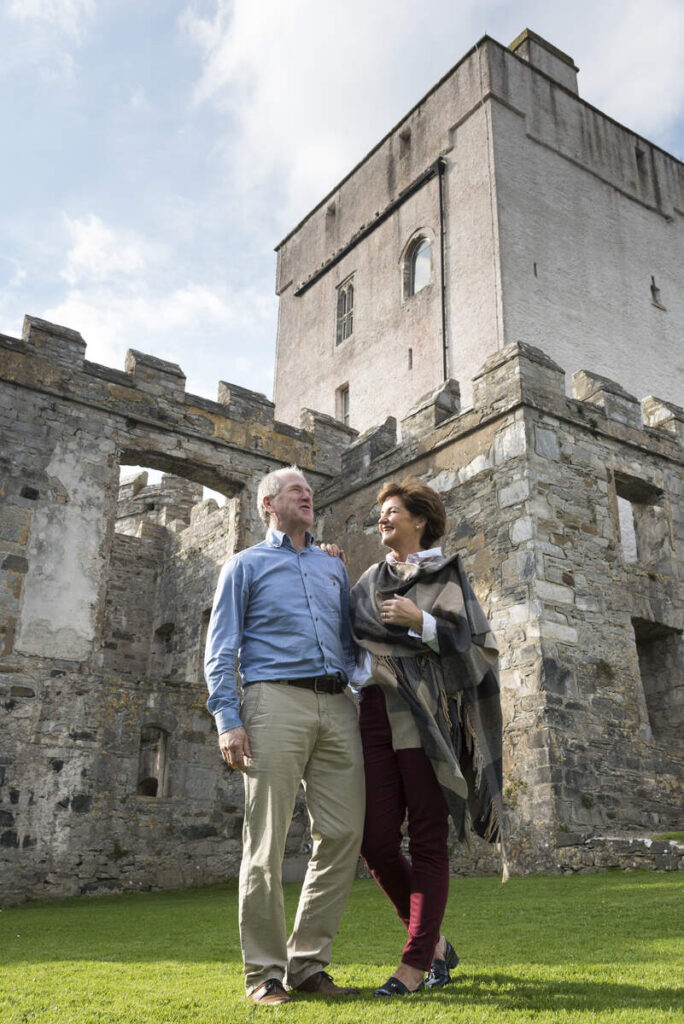
 Call Benny
Call Benny